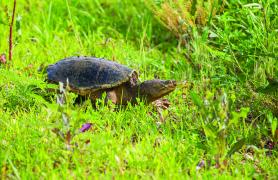Moonlight glimmers across a narrow stream. A sound, like someone crunching celery, carries through the darkness.
Suddenly, branches snap, and a tree crashes down. Timber!
A furry lumberjack waddles out of the gloom. Weighing up to 90 pounds and standing over 3 feet tall, the beaver is Missouri’s largest rodent. But size isn’t its most remarkable trait. Beavers are big-league builders, making dams and dens with only sticks, stones, and mud. Using its teeth, the beaver nips off a branch then slides into the water. Though the stream doesn’t know, its days of free-flowing freedom are numbered.
Tools of the Trade
Beavers don’t wear work belts, but they do have many tools to help with their wood-filled, waterlogged construction jobs.
- A fat, flat, scaly tail works like a rudder and a propeller when the beaver is swimming and like a kickstand when it balances on its hind feet to cut trees.
- Glands under the tail produce oil, which a beaver combs through its fur to help it repel water.
- Short, thick underfur keeps a beaver toasty in even the iciest water. Nearly 60,000 hairs cover each square inch of skin.
- Large, webbed feet act like flippers when swimming and like snowshoes when walking over squishy mud.
Masters of Downfall
Using only its teeth, a beaver can cut down a willow tree that’s thicker than your leg in under 5 minutes. Large trees usually take several nights to drop.
- A beaver’s five-fingered front paws are as nimble as a human’s hands. When a beaver eats the bark off a branch, it turns the stick in its paws as if it were corn on the cob.
- Wood is tough to digest. An army of bacteria lives in a beaver’s guts and helps break down the wood.
- A beaver’s front teeth are chainsaw-sharp and never stop growing. If a beaver didn’t gnaw wood every day, its chompers would soon outgrow its head.
- Beavers don’t brush their teeth, but that isn’t why they’re orange. Iron in the enamel turns the teeth rust-colored and makes them hard as steel.
- Long guard hairs trap air when a beaver dives. The air forms a waterproof barrier — like a surfer’s wetsuit— to keep the skin dry.
- Oversized lungs hold enough air to keep a beaver underwater for 15 minutes at a time.
- Valves in the ears and nose close tightly when a beaver dives.
- An extra set of eyelids is see-through and acts like swim goggles to protect the eyes underwater.
- Lips close behind the teeth, so a beaver can swim while carrying a mouthful of sticks.
Buck-Toothed Builders
Building is a family business. Mom, pop, and the kids work together to turn streams into wetlands, one tree at a time. Here’s how they do it.
- The beavers begin by stacking branches across the narrowest part of a stream. The branches are held down with rocks and plastered together with handfuls of mud.
- Branch by branch, a dam gets built. Water pools behind it, forming a wetland. Soon, the new habitat hums with life as ducks, herons, and muskrats move in.
- The family builds a sturdy house called a lodge. They pile branches to form a large mound. Then they dig doorways and a living chamber inside. Canals are dug to reach distant trees.
Lodged In
Like a castle surrounded by a moat, a lodge keeps the beaver family safe from enemies such as coyotes and bobcats.
- A layer of mud mortar holds the lodge together and keeps it draft-free.
- A single room, about 5 feet wide and 3 feet tall, serves as the family’s kitchen, living room, bedroom, and bathroom.
- In late spring, mama beaver gives birth to four beaver babies, called kits.
- Although the kits can swim just a few days later, they usually remain safely inside the lodge. The rest of the family brings back leaves and tender twigs for the babies to eat.
- Young beavers stay with their family until they’re 2 years old.
- The walls of the lodge are about 2 feet thick — enough to keep the inside cozy in the winter. A hole at the top lets in air to breathe.
- A slap of dad’s tail on the water cracks like a rifle shot. The sound warns the rest of the family that danger is near.
- Running water sounds like a fire alarm to a beaver. The tiniest trickle spurs the whole family into action to patch up the leak.
- Beavers are eager eaters, chowing down on more than 2 pounds of bark, leaves, and twigs each day.
- In the fall, beavers work overtime to gather food for winter. They clip tasty branches and stick them into the mud in the deepest part of their pond. When winter comes, family members swim under the ice to grab a snack from the “fridge.”


Also In This Issue

And More...
This Issue's Staff
Les Fortenberry
Karen Hudson
Angie Daly Morfeld
Noppadol Paothong
Marci Porter
Mark Raithel
Laura Scheuler
Matt Seek
David Stonner
Nichole LeClair Terrill
Stephanie Thurber
Cliff White






















